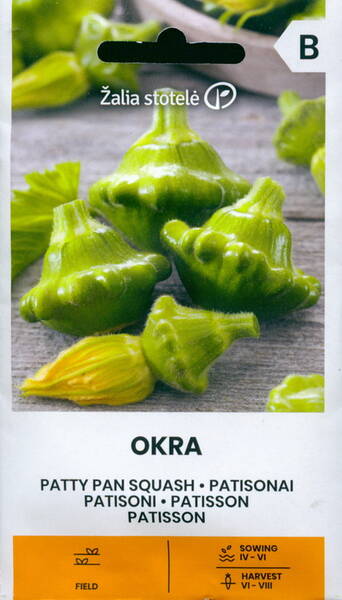Ex Tax: 1.14€
An early-ripening, green-fruited variety that bears fruit within 46-52 days after germination.
Forms bush plants with a compact habit. The fruits are disc-shaped, with a scalloped edge, light green in biological ripeness, weighing up to 300 g.
Young ovaries with a diameter of 5-8 cm are used for food. The pulp of young squash is tender, crispy, juicy, containing a complete vitamin and mineral complex. The high content of healthy fiber, pectin and low calorie content determine the dietary properties of the ovaries.
The fruits are used in home cooking for stewing, frying, stuffing, baking, and canning for the winter (including freezing). Productivity – 4-5 kg/m2.
Value of the variety: long harvest period, original colour.
Sowing seeds in open ground in holes of 2-3 pieces, to a depth of 3-5 cm. The optimal soil temperature for seed germination is +25+30°C.
Planting pattern: 70x70-100 cm. After the emergence of seedlings, thinning is carried out.
Regular watering, weeding, loosening and fertilizing are required. When harvested regularly, the plants bear fruit until the first frost.
* Origins from Central and South America. Widely grown in France, USA. This is a type of hard-bark pumpkin. In recent years, it has increasingly appeared in the beds of vegetable growers. It is grown less frequently than zucchini, since patty pan squash is more demanding on growing conditions.
Patisson (Patty pan squash) is a herbaceous plant of the pumpkin family. It does not form lashes, but forms a bush. Fruticose squash fruits have a variety of shapes, but most often they resemble discs.
Patisson is less productive and more heat-loving than zucchini. At +2°C the plants die.
The taste of squash resembles asparagus and artichoke, and when preserved, it resembles porcini mushrooms. The pulp of the fruit contains sugar, vitamin C, pectin, provitamins A, B1, B2, PP.
Patty pan squash is stewed, salted, pickled. They are also grown for decorative purposes - the plate-shaped fruits are very beautiful.
Fruticose squash fruits are useful for obesity, anemia, kidney disease, hypertension, atherosclerosis, and cardiovascular diseases.
Squash seeds begin to germinate at a temperature of +12+15°C. They germinate quickly at +25+27°C. Grows well at temperatures +18+25°C.
The stem of the patty pan squash is short - 50-150 cm. It is mainly a bush plant and does not produce lateral shoots. It blooms and forms ovaries until frost. The bark of the fruit at technical ripeness is soft and white. When ripe, the bark becomes woody. Previously, squash varieties only had white fruits. And now varieties have been created with fruits of yellow and orange color. These varieties contain carotene. There are also varieties with dark green fruits.
Scallop squash are demanding regarding lighting conditions. They grow poorly in partial shade, under trees, the yield is reduced, and the quality of the fruit deteriorates. The yield decreases when plantings become denser. In this case, rot may develop and the fruits may be affected. In order to ventilate the plantings, it is recommended to cut out some of the leaves.
Patisson is a moisture-loving crop. In hot weather they need to be watered generously, usually every other day. In cool weather, water rarely. Plants need to be watered with warm water to prevent root rot. The soil for squash requires light, fertile, water- and breathable, with a neutral reaction. They grow poorly on acidic, clay soils. It is better to apply lime (200-300 g/m2) under the previous crop. Clay soils need to be enriched with loosening materials - peat, humus, rotted sawdust, compost.
Requirements for mineral nutrition conditions vary depending on the phase of plant development. A lot of nitrogen is needed at the stage of leaf growth, and during fruit formation more phosphorus and potassium are required.












